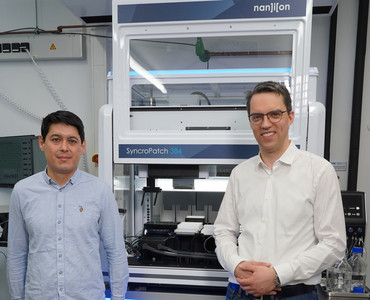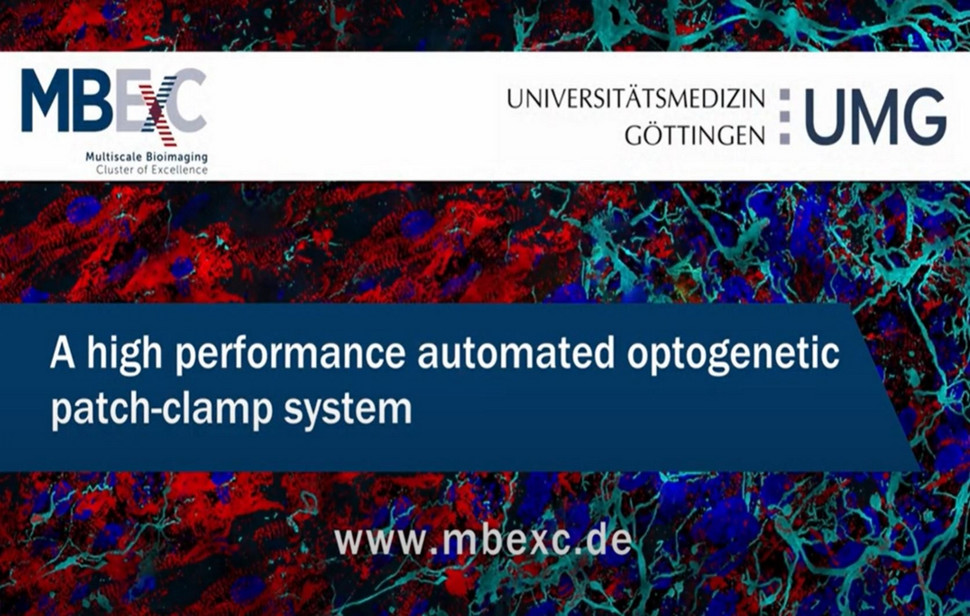Unique technology platform at the MBExC Cluster of Excellence combines cellular electrophysiology and optogenetics

(mbexc/umg) Electrical activity is one of the most important common features of the heart and the brain. The goal of the Göttingen Cluster of Excellence “Multiscale Bioimaging: From Molecular Machines to Networks of Excitable Cells (MBExC)” is to understand the functional properties of cardiomyocytes and neurons, which form the smallest electrically active units of both organs.
With the aim of advancing the direct investigation of the electrical activity of isolated cardiomyocytes and neurons, a technology platform has recently been established at the MBExC that uniquely enables high-throughput measurements of cellular electrophysiology. The platform is headed by MBExC associated investigator Prof. Dr. Niels Voigt from the Institute of Pharmacology and Toxicology at the University Medical Center Göttingen (UMG) and MBExC optogenetics application specialist Dr. Thomas Mager from the Institute for Auditory Neuroscience at the UMG.
The heart of the new platform is the MBExC-funded patch-clamp robot SyncroPatch 384 from Nanion Technologies. The SyncroPatch system is based on the patch-clamp technique developed by Nobel Laureates Prof. Dr. Erwin Neher and Prof. Dr. Bert Sakmann in the 1970s here in Göttingen. In contrast to the slow traditional technique, which requires manual investigation of each individual cell, the new system enables high-throughput measurements of electrical activity of hundreds of cells at once. "In other words, an experiment that normally requires more than one year of intensive work can now be performed automatically within a few hours," says Prof. Voigt, head of the technology platform. "We will use the system to study cardiomyocytes and neurons isolated from biopsies or derived from stem cells of patients. This technique virtually allows us to record ECG’s (electrocardiograms) and EEG’s (electroencephalograms) from single cardiomyocytes and neurons respectively. The goal is to uncover abnormal electrical cell behavior that may underlie severe cardiac or neurological disorders." In the long term, the MBExC aims to pave the way for developing therapeutic approaches for diseases of the heart such as cardiac arrhythmias and heart failure, and the brain such as Parkinson’s, Alzheimer’s and stroke.
Particularly innovative: The MBExC SyncroPatch system in Göttingen represents a unique prototype that allows for so called “optogenetic stimulation” in addition to high-throughput recordings of cellular electrophysiology. Optogenetics aims to control electrophysiological properties of single cells by the application of short light pulses. The basis of this technique is the availability of light-sensitive proteins within the cell that control its electrical properties. These proteins are introduced into the cells using modern genetic methods. The combination of high-throughput cellular electrophysiology and the stimulation of cellular activity by light enables scientists to develop new tools for optogenetics. To this end, a large-scale screening effort is envisioned to investigate mutant libraries of known light sensors and thusfare unknown natural variants which are currently hidden in the aquatic microbiome. "The discovery of new light sensors is crucial for the study of excitable cells such as neurons or cardiomyocytes," says Dr. Thomas Mager. "They hold enormous potential for future treatments such as optogenetic restoration of vision or hearing, which we are also working on at MBExC and the Institute for Auditory Neuroscience."
For MBExC research, the high-perfomance automated patch-clamp system represents an enormous added value: Its perfect applicability for the study of excitable cells now allows many multiscale and multidisciplinary projects to proceed. Unique in Europe, the newly established MBExC platform is open to all members of the Cluster of Excellence and scientists within the Göttingen Campus as well as external users.
The Göttingen Cluster of Excellence Multiscale Bioimaging: From Molecular Machines to Networks of Excitable Cells (MBExC) has been funded since January 2019 in the framework of the Excellence Strategy of the German Federal and State Governments. Applying a unique and multiscale approach, MBExC investigates the disease-relevant functional units of electrically active cells of heart and brain, from the molecular to the organ level. The MBExC unites numerous partners from the university and non-university institutions in Göttingen. The overall goal: To understand the relationship between heart and brain diseases, to link basic and clinical research, and thus to develop new therapeutic and diagnostic approaches with social implications.
FURTHER INFORMATION
Introductory video: https://www.youtube.com/watch?v=mGalM8lUiTw
about MBExC: https://mbexc.de/
University Medical Center Göttingen, University of Göttingen
Institute for Pharmacology and Toxicology
Molecular Pharmacology
Prof. Dr. Niels Voigt
Robert-Koch-Str. 40, 37075 Göttingen
Phone 049+ 551 / 39-65174, niels.voigt(at)med.uni-goettingen.de
University Medical Center Göttingen, University of Göttingen
Institute for Auditory Neuroscience
Dr. Thomas Mager, MBExC Application Specialist
Robert-Koch-Str. 40, 37075 Göttingen
Phone: 049+ 551-39-20719, thomas.mager(at)med.uni-goettingen.de
Cluster of Excellence Multiscale Bioimaging (MBExC)
Dr. Heike Conrad (contact - press releases)
Phone: 049+ 0551-39-61305, heike.conrad(at)med.uni-goettingen.de
